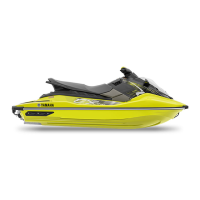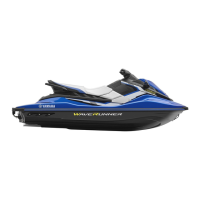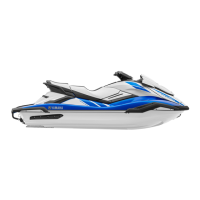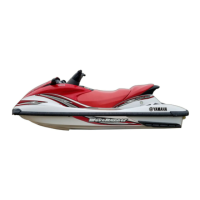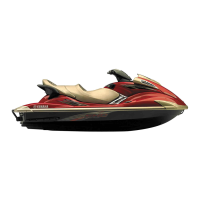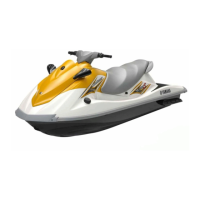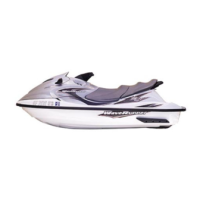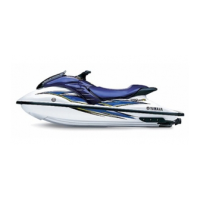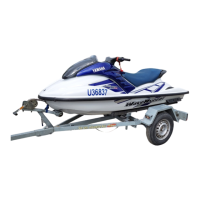Do you have a question about the Yamaha WaveRunner EX 2021 and is the answer not in the manual?
Provides essential guidance and explains manual conventions.
Explains how engine data is stored, used, and protected.
Details PRI-ID, HIN, and engine serial number locations and importance.
Details compliance with emission regulations and certifications for the engine.
Displays and explains various warning labels critical for safe operation.
Identifies and describes other important labels on the watercraft.
Specifies age, training, and passenger limits for safe watercraft operation.
Outlines safe operating practices, speed, and environmental awareness.
Details required safety gear, protective clothing, and eye protection.
Explains maritime navigation rules for safe interaction with other vessels.
Provides definitions for common watercraft terms and systems.
Visually identifies and labels major external and internal components.
Explains the function and operation of key controls like stop, shut-off, and start switches.
Details the operation of the throttle and RiDE levers for speed and directional control.
Explains how handlebar input controls the jet thrust nozzle for steering.
Covers basic functions like reverse systems and shift operations for different models.
Guides on how to safely turn the watercraft at various speeds and conditions.
Explains how to safely slow down and stop the watercraft without brakes.
Describes the functions and displays of the central information center.
Explains how to read speed and engine RPM for performance monitoring.
Details warning lights and buzzers for fuel, oil pressure, and engine overheat.
Details seat removal and the location and use of various storage compartments.
Explains the use of reboarding grips and steps for safely getting back on the watercraft.
Describes the use of bow eyes, stern eyes, and cleats for mooring and towing.
Specifies recommended fuel types, octane ratings, and safe refueling procedures.
Details recommended oil types, grades, and how to check the oil level correctly.
Instructions for draining bilge water to prevent engine damage and ensure proper operation.
Outlines the essential engine break-in procedure for optimal performance and longevity.
Provides a comprehensive checklist of pre-launch and post-launch checks for safety.
Details checks for fuel leakage, tank integrity, and fuel level for safe operation.
Instructions for inspecting the engine compartment for damage and ventilation.
General advice on getting familiar with controls and safe riding practices.
Step-by-step instructions for safely starting the engine on water.
Procedures for safely beaching and docking the watercraft near shorelines or docks.
Steps for cleaning and preparing the watercraft after use to prevent deterioration.
Guidance on removing, storing, and installing the watercraft battery for optimal life.
A chart outlining recommended maintenance intervals for various watercraft components.
A chart to help identify and resolve common operational problems and their causes.
Steps to take in emergency situations like cleaning jet intake or raising reverse gate.
Details the terms, conditions, and exclusions of the manufacturer's limited warranty.
Information on optional extended service plans for continued protection.
Provides essential guidance and explains manual conventions.
Explains how engine data is stored, used, and protected.
Details PRI-ID, HIN, and engine serial number locations and importance.
Details compliance with emission regulations and certifications for the engine.
Displays and explains various warning labels critical for safe operation.
Identifies and describes other important labels on the watercraft.
Specifies age, training, and passenger limits for safe watercraft operation.
Outlines safe operating practices, speed, and environmental awareness.
Details required safety gear, protective clothing, and eye protection.
Explains maritime navigation rules for safe interaction with other vessels.
Provides definitions for common watercraft terms and systems.
Visually identifies and labels major external and internal components.
Explains the function and operation of key controls like stop, shut-off, and start switches.
Details the operation of the throttle and RiDE levers for speed and directional control.
Explains how handlebar input controls the jet thrust nozzle for steering.
Covers basic functions like reverse systems and shift operations for different models.
Guides on how to safely turn the watercraft at various speeds and conditions.
Explains how to safely slow down and stop the watercraft without brakes.
Describes the functions and displays of the central information center.
Explains how to read speed and engine RPM for performance monitoring.
Details warning lights and buzzers for fuel, oil pressure, and engine overheat.
Details seat removal and the location and use of various storage compartments.
Explains the use of reboarding grips and steps for safely getting back on the watercraft.
Describes the use of bow eyes, stern eyes, and cleats for mooring and towing.
Specifies recommended fuel types, octane ratings, and safe refueling procedures.
Details recommended oil types, grades, and how to check the oil level correctly.
Instructions for draining bilge water to prevent engine damage and ensure proper operation.
Outlines the essential engine break-in procedure for optimal performance and longevity.
Provides a comprehensive checklist of pre-launch and post-launch checks for safety.
Details checks for fuel leakage, tank integrity, and fuel level for safe operation.
Instructions for inspecting the engine compartment for damage and ventilation.
General advice on getting familiar with controls and safe riding practices.
Step-by-step instructions for safely starting the engine on water.
Procedures for safely beaching and docking the watercraft near shorelines or docks.
Steps for cleaning and preparing the watercraft after use to prevent deterioration.
Guidance on removing, storing, and installing the watercraft battery for optimal life.
A chart outlining recommended maintenance intervals for various watercraft components.
A chart to help identify and resolve common operational problems and their causes.
Steps to take in emergency situations like cleaning jet intake or raising reverse gate.
Details the terms, conditions, and exclusions of the manufacturer's limited warranty.
Information on optional extended service plans for continued protection.
| Model | WaveRunner EX |
|---|---|
| Year | 2021 |
| Displacement | 1049cc |
| Fuel Type | Regular unleaded |
| Fuel Capacity | 13.2 gallons |
| Rider Capacity | 3 |
| Width | 3' 8" |
| Engine Type | 4-stroke, 3-cylinder, 4-valve |
